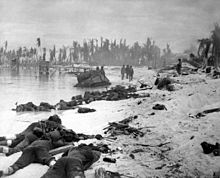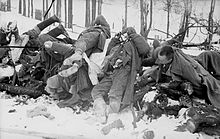World War II casualties
Contents[hide] |
Total dead
Recent historical scholarship
Classification of casualties
Human losses by country
Total deaths
| [hide] | ||||||||||||||||||||||||||||||||||||||||||||||||||||||||||||||||||||||||||||||||||||||||||||||||||||||||||||||||||||||||||||||||||||||||||||||||||||||||||||||||||||||||||||||||||||||||||||||||||||||||||||||||||||||||||||||||||||||||||||||||||||||||||||||||||||||||||||||||||||||||||||||||||||||||||||||||||||||||||||||||||||||||||||||||||||||||||||||||||||||||||||||||||||
|---|---|---|---|---|---|---|---|---|---|---|---|---|---|---|---|---|---|---|---|---|---|---|---|---|---|---|---|---|---|---|---|---|---|---|---|---|---|---|---|---|---|---|---|---|---|---|---|---|---|---|---|---|---|---|---|---|---|---|---|---|---|---|---|---|---|---|---|---|---|---|---|---|---|---|---|---|---|---|---|---|---|---|---|---|---|---|---|---|---|---|---|---|---|---|---|---|---|---|---|---|---|---|---|---|---|---|---|---|---|---|---|---|---|---|---|---|---|---|---|---|---|---|---|---|---|---|---|---|---|---|---|---|---|---|---|---|---|---|---|---|---|---|---|---|---|---|---|---|---|---|---|---|---|---|---|---|---|---|---|---|---|---|---|---|---|---|---|---|---|---|---|---|---|---|---|---|---|---|---|---|---|---|---|---|---|---|---|---|---|---|---|---|---|---|---|---|---|---|---|---|---|---|---|---|---|---|---|---|---|---|---|---|---|---|---|---|---|---|---|---|---|---|---|---|---|---|---|---|---|---|---|---|---|---|---|---|---|---|---|---|---|---|---|---|---|---|---|---|---|---|---|---|---|---|---|---|---|---|---|---|---|---|---|---|---|---|---|---|---|---|---|---|---|---|---|---|---|---|---|---|---|---|---|---|---|---|---|---|---|---|---|---|---|---|---|---|---|---|---|---|---|---|---|---|---|---|---|---|---|---|---|---|---|---|---|---|---|---|---|---|---|---|---|---|---|---|---|---|---|---|---|---|---|---|---|---|---|---|---|---|---|---|---|---|---|---|---|---|---|---|---|---|---|---|---|---|---|---|---|---|---|---|---|---|---|---|---|---|---|---|---|---|
|
- Figures rounded to the nearest hundredth place.
- Population in 1939 - Source: Population Statistics[10]
- War losses are for the national boundaries of 1939.
- Military casualties include deaths of regular military forces from combat as well as non combat causes. Partisan and resistancefighter deaths forces are included with military losses. The deaths of prisoners of war in captivity and personnel missing in action are also included with military deaths. The armed forces of the various nations are treated as single entities, for example the deaths of Austrians, Soviets, French and ethnic Germans in the Wehrmacht are included with German military losses. There is no reliable breakout of the war dead from Africa and Asia in the armed forces of France and the UK. France and the UK have never published an ethnic breakout of their losses.
- Civilian casualties include deaths caused by strategic bombing, Holocaust victims, Japanese war crimes, population transfers in the Soviet Union, Allied war crimes and deaths due to war related famine and disease. The exact breakdown is not always provided in the sources cited.
- Total Soviet losses in the postwar 1946–91 boundaries[11] were 26.6 million. (13.5% of the total population of 196.7 million)[12]
- Total Polish losses in the postwar 1946 boundaries[13] were about 3,600,000 (15.8% of the total population of 23.3 million)[14]
- Total Romanian losses in the postwar 1946 boundaries.[15] were 500,000 (2.5% of the total population of 15.9 million)[16]
- Total losses of Czechoslovakia in the post war 1946-1991 borders were about 250,000 (1.9% of the total population of 14.6 million.)[17]
Third Reich
| [hide] | |||||||||||||||||||||||||||||||||||||||||||
|---|---|---|---|---|---|---|---|---|---|---|---|---|---|---|---|---|---|---|---|---|---|---|---|---|---|---|---|---|---|---|---|---|---|---|---|---|---|---|---|---|---|---|---|
| |||||||||||||||||||||||||||||||||||||||||||
USSR
| [hide] | |||||||||||||||||||||||||||||||||||||||||||||||||||||||||||||||||||||||||||||||
|---|---|---|---|---|---|---|---|---|---|---|---|---|---|---|---|---|---|---|---|---|---|---|---|---|---|---|---|---|---|---|---|---|---|---|---|---|---|---|---|---|---|---|---|---|---|---|---|---|---|---|---|---|---|---|---|---|---|---|---|---|---|---|---|---|---|---|---|---|---|---|---|---|---|---|---|---|---|---|---|
| |||||||||||||||||||||||||||||||||||||||||||||||||||||||||||||||||||||||||||||||
| Soviet Republic | Population 1940 | Military Dead | Civilian Dead | Total | Deaths as % 1940 Pop. |
|---|---|---|---|---|---|
| Azerbaijan | 3,270,000 | 210,000 | 90,000 | 300,000 | 9.1% |
| Armenia | 1,320,000 | 150,000 | 30,000 | 180,000 | 13.6% |
| Belarus | 9,050,000 | 620,000 | 1,670,000 | 2,290,000 | 25.3% |
| Estonia | 1,050,000 | 30,000 | 50,000 | 80,000 | 7.6% |
| Georgia | 3,610,000 | 190,000 | 110,000 | 300,000 | 8.3% |
| Kazakhstan | 6,150,000 | 310,000 | 350,000 | 660,000 | 10.7% |
| Kyrgyzstan | 1,530,000 | 70,000 | 50,000 | 120,000 | 7.8% |
| Latvia | 1,890,000 | 30,000 | 230,000 | 260,000 | 13.7% |
| Lithuania | 2,930,000 | 25,000 | 350,000 | 375,000 | 12.7% |
| Moldova | 2,470,000 | 50,000 | 120,000 | 170,000 | 6.9% |
| Russia | 110,100,000 | 6,750,000 | 7,200,000 | 13,950,000 | 12.7% |
| Tajikistan (See Note Below) | 1,530,000 | 50,000 | 70,000 | 120,000 | 7.8% |
| Turkmenistan | 1,300,000 | 70,000 | 30,000 | 100,000 | 7.7% |
| Uzbekistan | 6,550,000 | 330,000 | 220,000 | 550,000 | 8.4% |
| Ukraine | 41,340,000 | 1,650,000 | 5,200,000 | 6,850,000 | 16.3% |
| Unidentified | - | 165,000 | 130,000 | 295,000 | |
| Total USSR | 194,090,000 | 10,700,000 | 15,900,000 | 26,600,000 | 13.7% |
- The source of the figures on the table is Vadim Erlikman. Poteri narodonaseleniia v XX veke : spravochnik. Moscow 2004. ISBN 5-93165-107-1 pp. 23–35 Erlikman notes that these figures are his estimates.
- Figure of 15.9 million civilian war dead includes 3-4 million deaths due to war related famine and disease in the interior regions not occupied by Nazi Germany.
- Figures for Belarus and the Ukraine include about 2 million civilian dead that are also listed in the total war dead of Poland.
- The Russian News Agency RIA Novosti puts the military losses of Tajikistan at 90,000 killed[24]
Holocaust deaths
- In Nazi extermination camps: According to Polish Institute of National Remembrance (IPN) researchers 2,830,000 Jews were murdered in the Nazi death camps (500,000 Belzec; 150,000 Sobibor; 850,000 Treblinka; 150,000 Chełmno; 1,100,000 Auschwitz; 80,000 Majdanek.[4] Raul Hilberg puts the Jewish death toll in the death camps, including Romanian Transnistria at 3.0 million.[27]
- In the USSR by the Einsatzgruppen: Raul Hilberg puts the Jewish death toll in the area of the mobile killing groups at 1.4 million.[27]
- Aggravated deaths in the Ghettos of Nazi-occupied Europe: Raul Hilberg puts the Jewish death toll in the Ghettos at 700,000.[27]
- Yad Vashem has identified the names of four million Jewish Holocaust dead.[28]
| Country | Pre-War Jewish population | Low Estimate | High Estimate |
|---|---|---|---|
| Austria | 191,000 | 50,000 | 65,000 |
| Belgium | 60,000 | 25,000 | 29,000 |
| Czech Republic(Bohemia & Moravia) | 92,000 | 77,000 | 78,300 |
| Denmark | 8,000 | 60 | 116 |
| Estonia | 4,600 | 1,500 | 2,000 |
| France | 260,000 | 75,000 | 77,000 |
| Germany | 566,000 | 135,000 | 142,000 |
| Greece | 73,000 | 59,000 | 67,000 |
| Hungary (borders 1940)[30] | 725,000 | 502,000 | 569,000 |
| Italy | 48,000 | 6,500 | 9,000 |
| Latvia | 95,000 | 70,000 | 72,000 |
| Lithuania | 155,000 | 130,000 | 143,000 |
| Luxembourg | 3,500 | 1,000 | 2,000 |
| Netherlands | 112,000 | 100,000 | 105,000 |
| Norway | 1,700 | 800 | 800 |
| Poland | 3,250,000 | 2,700,000 | 3,000,000 |
| Romania (Borders 1940) | 441,000 | 121,000 | 287,000 |
| Slovakia | 89,000 | 60,000 | 71,000 |
| Soviet Union (Borders 1939) | 2,825,000 | 700,000 | 1,100,000 |
| Yugoslavia | 68,000 | 56,000 | 65,000 |
| Total | 9,067,000 | 4,869,860 | 5,894,716 |
- Roma: Most estimates of Roma (Gypsies) victims range from 130,000 to 500,000[34][37][38] Ian Hancock, Director of the Program of Romani Studies and the Romani Archives and Documentation Center at the University of Texas at Austin, has argued in favour of a higher figure of between 500,000 and 1,500,000 Roma dead.[39] Hancock writes that, proportionately, the death toll equaled "and almost certainly exceed[ed], that of Jewish victims."[40] In a 2010 publication, Ian Hancock stated that he agrees with the view that the number of Romanis killed has been underestimated as a result of being grouped with others in Nazi records under headings such as "remainder to be liquidated", "hangers-on" and "partisans".[41]
- Handicapped persons: 200,000 to 250,000 handicapped persons were victims of NaziEuthanasia[42] A 2003 report by the German Federal Archive put the total murdered during the Action T4 and "14f13," euthanasia programs at 200,000[43][44]
- Prisoners of War: POW deaths in Nazi captivity totaled 3.1 million[45] including 2.6 to 3 million Soviet prisoners of war.[46]
- Ethnic Poles: 1.8 to 1.9 million ethnic Polish civilians were victims during the German occupation. (see Nazi crimes against ethnic Poles).[47]
- Russians, Ukrainians and Belarusians: Sources in the English language estimate 4.5 to 11.7 million Soviet civilians were victims of Nazi ethnic cleansing and the war.[48][49][50] A report published by the Russian Academy of Science in 1995 put the civilian death toll due to the German occupation at 13.7 million.[51][52] Contemporary Russian sources use the terms "genocide" and "premeditated extermination" when referring to civilian losses in the occupied USSR. Civilians killed in reprisals during the Soviet partisan war and wartime related famine account for a major part the huge toll.[53] Russian sources include Jewish Holocaust deaths with total civilian deaths and do not list them separately.
- Other victims of Nazi persecution: Between 1,000 to 2,000 Roman Catholic clergy,[55] about 1,000 Jehovah's Witnesses,[56] and an unknown number of Freemasons.[57] "The fate of black people from 1933 to 1945 in Nazi Germany and in German-occupied territories ranged from isolation to persecution, sterilization, medical experimentation, incarceration, brutality, and murder."[58]During the Nazi era Communists, Socialists, Social Democrats, and trade union leaders were victims of Nazi persecution.[59]
- Serbs: (See World War II persecution of Serbs.)The numbers of Serbs persecuted by the Ustaše is the subject of much debate and estimates vary widely. Yad Vashem estimates over 500,000 murdered, 250,000 expelled and 200,000 forcibly converted to Catholicism.[60] The estimate of the United States Holocaust Memorial Museum is that the Ustaša authorities murdered between 320,000 and 340,000 ethnic Serb residents of Croatia and Bosnia during the period of Ustaše rule, out of which between 45,000 and 52,000 were murdered in the Jasenovac concentration camp.[61]
| Country | Pre-War Roma population | Low Estimate | High Estimate |
|---|---|---|---|
| Austria | 11,200 | 6,800 | 8,250 |
| Belgium | 600 | 350 | 500 |
| Czech Republic(Bohemia & Moravia) | 13,000 | 5,000 | 6,500 |
| Estonia | 1,000 | 500 | 1,000 |
| France | 40,000 | 15,150 | 15,150 |
| Germany | 20,000 | 15,000 | 15,000 |
| Greece | ? | 50 | 50 |
| Hungary | 100,000 | 1,000 | 28,000 |
| Italy | 25,000 | 1,000 | 1,000 |
| Latvia | 5,000 | 1,500 | 2,500 |
| Lithuania | 1,000 | 500 | 1,000 |
| Luxembourg | 200 | 100 | 200 |
| Netherlands | 500 | 215 | 500 |
| Poland | 50,000 | 8,000 | 35,000 |
| Romania | 300,000 | 19,000 | 36,000 |
| Slovakia | 80,000 | 400 | 10,000 |
| Soviet Union(Borders 1939) | 200,000 | 30,000 | 35,000 |
| Yugoslavia | 100,000 | 26,000 | 90,000 |
| Total | 947,500 | 130,565 | 285,650 |
Japanese war crimes
- R. J. Rummel estimates the civilian victims at 5,424,000. Detailed by country: China 3,695,000; Indochina 457,000; Korea 378,000; Indonesia 375,000; Malaya-Singapore 283,000; Philippines 119,000, Burma 60,000 and Pacific Islands 57,000. Rummel estimates POW deaths in Japanese custody at 539,000 Detailed by country: China 400,000; French Indochina 30,000; Philippines 27,300; Netherlands 25,000; France 14,000; UK 13,000; UK-Colonies 11,000; US 10,700; Australia 8,000.[8][63]
- Werner Gruhl estimates the civilian victims at 20,365,000. Detailed by country: China 12,392,000; Indochina 1,500,000; Korea 500,000; Dutch East Indies 3,000,000; Malaya and Singapore 100,000; Philippines 500,000; Burma 170,000; Forced laborers in Southeast Asia 70,000, 30,000 interned non-Asian civilians; Timor 60,000; Thailand and Pacific Islands 60,000.[64] Gruhl estimates POW deaths in Japanese captivity at 331,584. Detailed by country: China 270,000; Netherlands 8,500; U.K. 12,433; Canada 273; Philippines 20,000; Australia 7,412; New Zealand 31; and the United States 12,935[64]
- The historian Chalmers Johnson has written that “the Japanese slaughtered as many as 30 million Filipinos, Malays, Vietnamese,Cambodians, Indonesians and Burmese, at least 23 million of them ethnic Chinese[65]
- Out of “60,000" Indian Army POWs taken at the Fall of Singapore, 11,000 died in captivity[66]
- There were 14,657 deaths among the total 130,895 western civilians interned by the Japanese due to famine and disease.[67][68]
Repression in the Soviet Union
Reported deaths for the years 1939-1945: 1,187,783, including Judicial Executions: 46,350; Deaths in Gulag labor camps: 718,804 Deaths in labor colonies and prisons: 422,629.[85]
Deported from annexed territories 1940-41- 380,000 to 390,000 persons including Poland 309-312,000; Lithuania 17,500; Latvia 17,000; Estonia 6,000; Moldova 22,842.[86] In August 1941, 243,106 Poles living in the Special Settlements were amnestied and released by the Soviets.[87]
Deported during the War 1941-1945- About 2.3 million persons of Soviet ethnic minorities including: Soviet Germans 1,209,000; Finns 9,000; Karachays 69,000; Kalmyks 92,000;Chechens and Ingush 479,000; Balkars 37,000; Crimean Tatars 191,014; Meskhetian Turks91,000; Greeks, Bulgarians and Armenians from Crimea 42,000; Ukranian OUN members 100,000; Poles 30,000.[88]
A total of 2,230,500[89] persons were living in the settlements in October 1945 and 309,100 deaths were reported in Special Settlements for the years 1941-1948[90]
Military casualties by branch of service
| [hide] | ||||||||||||||||||||||||||||||||||||||||||||||||||||||||||||||||||||||||||||||||||||||||||||||||||||||||||||||||||||||||||||||||||||||||||||||||||||||||||||||||||||||||||||||||||||||||||||||||||||||||||||||||||||||||||||||||||||||||||||||
|---|---|---|---|---|---|---|---|---|---|---|---|---|---|---|---|---|---|---|---|---|---|---|---|---|---|---|---|---|---|---|---|---|---|---|---|---|---|---|---|---|---|---|---|---|---|---|---|---|---|---|---|---|---|---|---|---|---|---|---|---|---|---|---|---|---|---|---|---|---|---|---|---|---|---|---|---|---|---|---|---|---|---|---|---|---|---|---|---|---|---|---|---|---|---|---|---|---|---|---|---|---|---|---|---|---|---|---|---|---|---|---|---|---|---|---|---|---|---|---|---|---|---|---|---|---|---|---|---|---|---|---|---|---|---|---|---|---|---|---|---|---|---|---|---|---|---|---|---|---|---|---|---|---|---|---|---|---|---|---|---|---|---|---|---|---|---|---|---|---|---|---|---|---|---|---|---|---|---|---|---|---|---|---|---|---|---|---|---|---|---|---|---|---|---|---|---|---|---|---|---|---|---|---|---|---|---|---|---|---|---|---|---|---|---|---|---|---|---|---|---|---|---|---|---|---|---|---|---|---|---|---|---|---|---|---|---|---|---|
| ||||||||||||||||||||||||||||||||||||||||||||||||||||||||||||||||||||||||||||||||||||||||||||||||||||||||||||||||||||||||||||||||||||||||||||||||||||||||||||||||||||||||||||||||||||||||||||||||||||||||||||||||||||||||||||||||||||||||||||||
Germany
USSR
British Commonwealth
U.S.
|

























